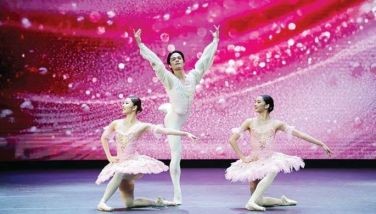Opening up

BERLIN – Acting students have taken over Checkpoint Charlie, the crossing along the Berlin Wall where US forces and their allies the Brits and French used to eyeball East German and Russian troops across one of the most notorious symbols of the Cold War.
Visitors can now stand between two youthful actors in East German uniform, who for two euros (about P120) will strike two poses – one saluting and another brandishing rifles – while a third uniformed actor takes the photos in front of the checkpoint. The money goes to the actors’ group.
Locals say the actors took over the spot and began collecting money without asking for permission from the government. But tourists don’t know this and no one challenges the setup.
It’s been like the Wild, Wild West in the former East Germany since the Berlin Wall came down in November 1989.
East Germans’ hardships, discontent and refusal to let a wall prevent them from crossing the border to seek greener pastures in the West put Germany on the path to reunification.
The fall of the wall has also led to a renaissance of sorts for Berlin, which in 1990 was restored as capital of the Federal Republic of Germany.
Jurgen Schepers, coordinator for creative industries of the Berlin Chamber of Industry and Commerce, said that after the fall, “Anyone could do anything he wanted.”
When President Aquino visits this city for the first time ever later this month, he and his team may pick up pointers on how a divided nation can rise from reunification pains, the ravages of two world wars and a terrible past to recover dramatically and become Europe’s strongest economy.
Opening up its economy and its labor market and strengthening its institutions have done wonders for Berlin. How the Germans achieved what has been touted as an economic miracle should be of interest to President Aquino.
P-Noy will be coming here as our two countries celebrate the 60th year of diplomatic ties.
Filipinos and Germans have shared values on democracy and human rights, and P-Noy is expected to discuss with German Chancellor Angela Merkel the popular freedom movements in the two countries.
* * *
Checkpoint Charlie is now surrounded by souvenir shops, trendy cafes and stalls selling currywurst. Hop-on, hop-off tourist buses are ubiquitous all over the city.
Merkel, born in Hamburg but bred in East Berlin, now holds office in this city. From a tourist bus last Sunday, I could see many people on the banks of the Spree River near the chancellery, sunning themselves as they sat on the grass or folding chairs after the morning’s torrential rains.
The city can use a smile campaign similar to what the Hong Kong and Singapore governments urged their people to do to attract more visitors. But the city has seen a leap in tourist arrivals in just five years, from three million to 11 million, and its problem now is how to cope with a continuing increase as people explore a city that was once closed to the world.
The new Berlin has become a magnet for new ideas, which is welcomed by a government that puts a premium on innovation.
Patches of drab East German industrial architecture are still visible. Along the Karl-Marx Allee, five-story buildings still have murals of that era on exterior walls, paying homage to workers of the socialist state. Locals used to call the boulevard Stalin’s Allee and the buildings Stalin’s bathtub, for the Meissen porcelain tiles used on the interior walls.
The bus tour gives visitors interesting glimpses into the bygone era, with the taped voice pointing to the Hotel InterContinental (still around) as the favorite of FBI and CIA agents.
There’s little left of the wall, but a lot of tourism activities still revolve around the events that led to its fall.
These days a symbol of East German backwardness, the Trabant automobile whose chassis was made of reinforced plastic, has been relegated to museums and its images used for touristy souvenirs.
The other top tourist draw, of course, is the history of Nazism and the Holocaust. There is the open area where the Nazi secret police used to torture people, a guide points out. Here is Bebelplatz in front of Humboldt University where the Nazis burned a mountain of books owned by Jews on May 10, 1933. “The Empty Library” is now on display on the ground in the open space.
The Jewish Museum has an ultra-modern, moving exhibit, which effectively projects the feeling of emptiness that comes to those facing unspeakable horror.
* * *
With the fall of the Berlin Wall, the city saw an influx of youthful avant-garde artists from the former West and other countries who relished the low cost of living in the former East and the anything goes environment.
At the same time, the government launched a massive reconstruction program, modernizing infrastructure and restoring or rebuilding facilities destroyed by two wars.
“Every day you find something new in this town,” Schepers says as he talks about the vibrant club scene and the whopping 32 billion euros that the creative industries brought in for Berlin in 2011-2012. The figure does not count tourism.
Fashion has been added to Berlin’s creative industries, which include not only the arts but also mass media, books, advertising and computer games.
Rebuilding doesn’t come cheap; there is an ongoing debate on the wisdom of reconstructing the former castle of the German emperor.
With growing prosperity also come higher living costs. Schepers is worried that it could drive away youthful creativity from the city.
Germans from both sides of the former wall also admit that inequalities remain in the reunified country. There are complaints of former East Germans suffering discrimination, but for the most part the reunification process has been remarkably free of major social upheavals.
The government has made an effort to make economic growth after reunification inclusive – a buzzword of daang matuwid. In the case of Germany, however, inclusive growth is not just lip service.
The biggest lesson that P-Noy can take away from his visit, however, is the impact of opening up.
“In former times, Berlin was an island,” said Schepers. After reunification, “Berlin was open to everything.”
P-Noy will see the results.
- Latest
- Trending

























